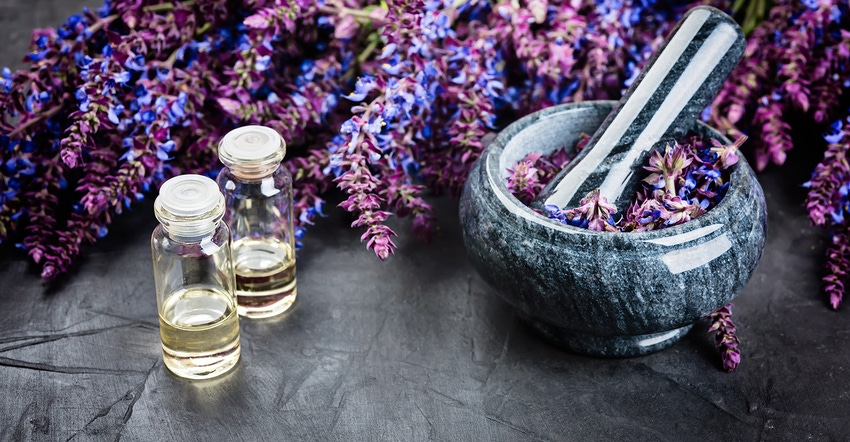Sage, a traditional medicine used by Greek, Roman, Ayurvedic, Native American and Chinese cultures, is undergoing more westernized scientific scrutiny.

Across the world, people are driven to become healthier, with an increased focus on wellness. According to Nielsen, the four macro-environmental trends that contribute to this are: an aging population; rising disease rates; increased interest in self-care, treatment and prevention; and the expansion of the educated and connected consumer.
The information age has bestowed a universal understanding about health issues, such as the opioids epidemic, and many people are becoming proactive and moving toward a more natural, traditional approach for their health care routines. In fact, the number of U.S. adults using dietary supplements increased 10% over the past decade, according to a consumer survey commissioned by the Council for Responsible Nutrition (CRN), and U.S. herbal supplements sales rose 8.5% in 2017, topping in at just over US$8 billion, according to the HerbalGram, published by the American Botanical Council (ABC).
The use of herbal medicinal products and supplements across the globe have also increased tremendously, with nearly 80 percent of people relying on them for part of their primary healthcare.1
As people around the world continue to look back at traditional medicines and incorporate herbal-based remedies and dietary supplements, an ancient herbal solution has a longstanding reputation used by Greek, Roman, Ayurvedic, Native American and Chinese medicines:2 Salvia officinalis, or more commonly known as sage.
The early stage of sage
Sage has been historically used in both medicinal and culinary purposes. It is a plant of the Lamiaceae family, and is native to the Middle East and the Mediterranean. The genus Salvia derives from the Latin word salvere, meaning “to save,” which may refer to the long-proposed healing properties of the plant.3 S. officinalis is one of the oldest cultivated species of sage, having a long history of use with recorded applications dating back to the first century (Pliny the Elder).3
This plant has been traditionally used for the treatment of various ailments including wound healing, cough and dizziness relief, according to an article on sage in HerbalGram, and behavioral functions like depression, memory enhancement and cognitive function.2 Sage has also been noted for strengthening the nervous system.4
Sage was in common usage throughout medieval times in Europe and featured in British herbal apothecaries from the 16th century onwards.5 In the 1500s, an English herbalist by the name of John Gerard claimed that sage was good for the brain, head and memory, and in the 1600s Nicholas Culpeper, a physician and herbalist, reported sage improved memory, noted HerbalGram.
Consistent with its traditional uses, sage has now been clinically studied to show a wide range of pharmacological properties including anti-inflammatory, antioxidant, antimicrobial and strong cognitive benefits.7
Sage in all shapes
Sage is a perennial round shrub cultivated in different European countries, and the major phytochemicals in the flowers, leaves and stem are well identified. 2 Sage leaves can be chewed whole, dried and ground into a powder; prepared as a fluid extract, tincture, or essential oil; or pressed fresh for the juice, according to HerbalGram. However, the leaf is the primary part of the plant used in most herbal preparations of sage. The phytochemical profile and phytotherapy will depend on how the Salvia species is prepared, where it is grown, and when it is harvested.6 As with all herbs, it is crucial that the source and preparation of the Salvia are consistent with the supporting clinical data to ensure a high level of effectiveness.
In a study by Moss et al. (2010), the cognitive and mood effects of aromatherapy using essential oils from two sage species (officinalis and lavandulafolia) were measured.9 While some results of the essential oil aromas matched some of those seen with orally administered herbal preparations of the same species, the range of benefits were not as broad as the oral preparations.
Making it mainstream
Herbal supplementation has not always had the data or regulatory support to make it to the mainstream user, and as people demand more information on what they consume, they also insist on proven efficacy. Meaning, the traditional use for an ingredient must be supported by current clinical or pre-clinical data. Recent investigative studies have been conducted to document the conventional use of sage and find new biological effects of this plant.
The 900 species of Salvia make it the largest genus of the Lamiaceae family.6 Of these, three—Salvia officinalis, S. lavandulaefolia and S. miltiorrhiza—are particularly notable for their reputed beneficial effects on behavioral function including depression, memory disorders and age-related memory decline.9,10,11
Specifically, studies conducted with extracts of S. officinalis demonstrated a pronounced effect on cognitive performance in both healthy young adults12 those 65 years and older.9 The dose-response study had a clear benefit in key cognitive performance (working memory, secondary memory and accuracy of attention) in as early as one hour of administering the proprietary sage extract. 9
Healthy aging has quickly become a concern for all generations, and the term overwhelmingly refers to maintaining cognitive and physical health, according to Nielsen. Traditionally, cognitive well-being may have been perceived as a concern for our senior years, however, over the past 12 years, the importance of cognitive function among all generations has grown more than 20% among American consumers, according to the Natural Marketing Institute (NMI). In addition, the number of people over the age of 60 is expected to double by 2050, according to data from The World Health Organization (WHO). This means brands have a great opportunity to help consumers bridge the gap between living longer and living healthier. With the advancements of clinical data, CPG brand owners have the chance to prove that natural healing remedies can be a solution to help improve health care for all generations.
For related content, check out Natural Products Insider's Botanicals digital magazine.
Kieron Edwards, Ph.D., scientific director at Sibelius Natural Products, obtained a doctorate in plant genetics at the University of Warwick, and then gained over 10 years’ experience in biological research in both an academic and industrial setting, most recently with Advanced Technologies Cambridge Ltd., including its subsequent merger into British American Tobacco. Over this time, he used genetic, genomic, transcriptomic, metabolomic and other systems approaches to investigate the regulation of physiological and biochemical traits in plants to support both fundamental understanding and trait development. In addition to his scientific training, Edwards completed his master of business administration at the University of Cambridge Judge Business school in 2016.
References
Ekor M. “The growing use of herbal medicines: issues relating to adverse reactions and challenges in monitoring safety.” Front Pharmacol. 2014 Jan 10;4:177. DOI: 10.3389/fphar.2013.00177.
Miroddi M et al. “Systematic review of clinical trials assessing pharmacological properties of Salvia species on memory, cognitive impairment and Alzheimer's disease.” CNS Neurosci Ther. 2014 Jun;20(6):485-95. DOI: 10.1111/cns.12270.
Grdisa M et al. “Dalmation Sage (Salvia officinals L.): A review of biochemical Contents, Medical Properties and Genetic Diversity.” Agriculturae Conspectus Scientificus (ACS).2015;80:69-78.
Imanshahidi M, Hosseinzadeh H. “The pharmacological effects of Salvia species on the central nervous system.” Phytother Res. 2006 Jun;20(6):427-37.
Crellin J, Philpot, J. “A Reference Guide to Medicinal Plants.” Duke University Press. 1990. ISBN-10: 0822310198
Ghorbani A, Esmaeilizadeh M. “Pharmacological properties of Salvia officinalis and its components.” J Tradit Complement Med. 2017 Jan 13;7(4):433-440. DOI: 10.1016/j.jtcme.20112.014. eCollection 2017 Oct.
Hamidpour M et al. “Chemistry, Pharmacology, and Medicinal Property of Sage (Salvia) to Prevent and Cure Illnesses Such as Obesity, Diabetes, Depression, Dementia, Lupus, Autism, Heart Disease, and Cancer.” J Tradit Complement Med. 2014 Apr;4(2):82-8. DOI: 10.4103/2225-4110.130373.
Moss L, et al. “Differential Effects of the Aromas of Salvia Species on Memory and Mood.” Hum Psychopharmacol, July 2010, DOI:10.1002/hup.1129.
Scholey A et al. “An extract of Salvia (sage) with anticholinesterase properties improves memory and attention in healthy older volunteers.” Psychopharmacology (Berl). 2008 May;198(1):127-3 DOI: 10.1007/s00213-008-1101-3.
Miroddi M et al. “Systematic review of clinical trials assessing pharmacological properties of Salvia species on memory, cognitive impairment and Alzheimer's disease.” CNS Neurosci Ther. 2014 Jun;20(6):485-95. DOI: 1111/cns.12270.
Ozarowski M et al. “Effect of Salvia miltiorrhiza root extract on brain acetylcholinesterase and butyrylcholinesterase activities, their mRNA levels and memory evaluation in rats.” Physiol Behav. 2017 May 1;173:223-230. DOI: 10.1016/j.physbeh.2017.02.019.
Kennedy D et al. “Effects of cholinesterase inhibiting sage (Salvia officinalis) on mood, anxiety and performance on a psychological stressor battery.” Neuropsychopharmacology. 2006 Apr;31(4):845-52.
About the Author(s)
You May Also Like






.png?width=800&auto=webp&quality=80&disable=upscale)